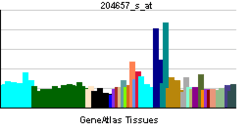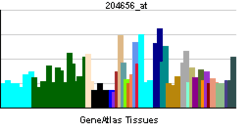SHB (gene)
| Src homology 2 domain containing adaptor protein B | |||||||||||||
|---|---|---|---|---|---|---|---|---|---|---|---|---|---|
| Identifiers | |||||||||||||
| Symbols | SHB ; bA3J10.2 | ||||||||||||
| External IDs | OMIM: 600314 MGI: 98294 HomoloGene: 74458 GeneCards: SHB Gene | ||||||||||||
| |||||||||||||
| RNA expression pattern | |||||||||||||
 | |||||||||||||
 | |||||||||||||
| More reference expression data | |||||||||||||
| Orthologs | |||||||||||||
| Species | Human | Mouse | |||||||||||
| Entrez | 6461 | 230126 | |||||||||||
| Ensembl | ENSG00000107338 | ENSMUSG00000044813 | |||||||||||
| UniProt | Q15464 | Q6PD21 | |||||||||||
| RefSeq (mRNA) | NM_003028 | NM_001033306 | |||||||||||
| RefSeq (protein) | NP_003019 | NP_001028478 | |||||||||||
| Location (UCSC) | Chr 9: 37.92 – 38.07 Mb | Chr 4: 45.42 – 45.53 Mb | |||||||||||
| PubMed search | |||||||||||||
SH2 domain-containing adapter protein B is a protein that in humans is encoded by the SHB gene.[1][2]
Interactions
SHB (gene) has been shown to interact with Fibroblast growth factor receptor 1,[3] Src,[3] Linker of activated T cells,[4][5] Lymphocyte cytosolic protein 2,[5] ZAP-70,[5] EPS8,[3] PIK3R1[3] and VAV1.[5]
References
- ↑ Yulug IG, Hillermann R, Fisher EM (May 1995). "The SHB adaptor protein maps to human chromosome 9". Genomics 24 (3): 615–7. doi:10.1006/geno.1994.1681. PMID 7713524.
- ↑ "Entrez Gene: SHB Src homology 2 domain containing adaptor protein B".
- ↑ 3.0 3.1 3.2 3.3 Karlsson, T; Songyang Z, Landgren E, Lavergne C, Di Fiore P P, Anafi M, Pawson T, Cantley L C, Claesson-Welsh L, Welsh M (Apr 1995). "Molecular interactions of the Src homology 2 domain protein Shb with phosphotyrosine residues, tyrosine kinase receptors and Src homology 3 domain proteins". Oncogene (ENGLAND) 10 (8): 1475–83. ISSN 0950-9232. PMID 7537362.
- ↑ Lindholm, C K; Gylfe E; Zhang W; Samelson L E; Welsh M (Sep 1999). "Requirement of the Src homology 2 domain protein Shb for T cell receptor-dependent activation of the interleukin-2 gene nuclear factor for activation of T cells element in Jurkat T cells". J. Biol. Chem. (UNITED STATES) 274 (39): 28050–7. doi:10.1074/jbc.274.39.28050. ISSN 0021-9258. PMID 10488157.
- ↑ 5.0 5.1 5.2 5.3 Lindholm, Cecilia K; Henriksson Maria L; Hallberg Bengt; Welsh Michael (Jul 2002). "Shb links SLP-76 and Vav with the CD3 complex in Jurkat T-1 cells". Eur. J. Biochem. (Germany) 269 (13): 3279–88. doi:10.1046/j.1432-1033.2002.03008.x. ISSN 0014-2956. PMID 12084069.
Further reading
- Karlsson T; Songyang Z; Landgren E et al. (1995). "Molecular interactions of the Src homology 2 domain protein Shb with phosphotyrosine residues, tyrosine kinase receptors and Src homology 3 domain proteins". Oncogene 10 (8): 1475–83. PMID 7537362.
- Welsh M; Mares J; Karlsson T et al. (1994). "Shb is a ubiquitously expressed Src homology 2 protein". Oncogene 9 (1): 19–27. PMID 8302579.
- Karlsson T, Welsh M (1996). "Apoptosis of NIH3T3 cells overexpressing the Src homology 2 domain protein Shb". Oncogene 13 (5): 955–61. PMID 8806685.
- Welsh M; Songyang Z; Frantz JD et al. (1998). "Stimulation through the T cell receptor leads to interactions between SHB and several signaling proteins". Oncogene 16 (7): 891–901. doi:10.1038/sj.onc.1201607. PMID 9484780.
- Karlsson T, Kullander K, Welsh M (1998). "The Src homology 2 domain protein Shb transmits basic fibroblast growth factor- and nerve growth factor-dependent differentiation signals in PC12 cells". Cell Growth Differ. 9 (9): 757–66. PMID 9751119.
- Lindholm CK; Gylfe E; Zhang W et al. (1999). "Requirement of the Src homology 2 domain protein Shb for T cell receptor-dependent activation of the interleukin-2 gene nuclear factor for activation of T cells element in Jurkat T cells". J. Biol. Chem. 274 (39): 28050–7. doi:10.1074/jbc.274.39.28050. PMID 10488157.
- Dixelius J; Larsson H; Sasaki T et al. (2000). "Endostatin-induced tyrosine kinase signaling through the Shb adaptor protein regulates endothelial cell apoptosis". Blood 95 (11): 3403–11. PMID 10828022.
- Hooshmand-Rad R; Lu L; Heldin CH et al. (2000). "Platelet-derived growth factor-mediated signaling through the Shb adaptor protein: effects on cytoskeletal organization". Exp. Cell Res. 257 (2): 245–54. doi:10.1006/excr.2000.4896. PMID 10837138.
- Lu L; Annerén C; Reedquist KA et al. (2000). "NGF-Dependent neurite outgrowth in PC12 cells overexpressing the Src homology 2-domain protein shb requires activation of the Rap1 pathway". Exp. Cell Res. 259 (2): 370–7. doi:10.1006/excr.2000.4984. PMID 10964504.
- Diakonova M, Gunter DR, Herrington J, Carter-Su C (2002). "SH2-Bbeta is a Rac-binding protein that regulates cell motility". J. Biol. Chem. 277 (12): 10669–77. doi:10.1074/jbc.M111138200. PMID 11786545.
- Lindholm CK, Henriksson ML, Hallberg B, Welsh M (2002). "Shb links SLP-76 and Vav with the CD3 complex in Jurkat T cells". Eur. J. Biochem. 269 (13): 3279–88. doi:10.1046/j.1432-1033.2002.03008.x. PMID 12084069.
- Cross MJ; Lu L; Magnusson P et al. (2003). "The Shb Adaptor Protein Binds to Tyrosine 766 in the FGFR-1 and Regulates the Ras/MEK/MAPK Pathway via FRS2 Phosphorylation in Endothelial Cells". Mol. Biol. Cell 13 (8): 2881–93. doi:10.1091/mbc.E02-02-0103. PMC 117949. PMID 12181353.
- Lindholm CK (2002). "IL-2 receptor signaling through the Shb adapter protein in T and NK cells". Biochem. Biophys. Res. Commun. 296 (4): 929–36. doi:10.1016/S0006-291X(02)02016-8. PMID 12200137.
- Holmqvist K, Cross M, Riley D, Welsh M (2003). "The Shb adaptor protein causes Src-dependent cell spreading and activation of focal adhesion kinase in murine brain endothelial cells". Cell. Signal. 15 (2): 171–9. doi:10.1016/S0898-6568(02)00076-1. PMID 12464388.
- Strausberg RL; Feingold EA; Grouse LH et al. (2003). "Generation and initial analysis of more than 15,000 full-length human and mouse cDNA sequences". Proc. Natl. Acad. Sci. U.S.A. 99 (26): 16899–903. doi:10.1073/pnas.242603899. PMC 139241. PMID 12477932.
- Welsh N, Makeeva N, Welsh M (2003). "Overexpression of the Shb SH2 domain-protein in insulin-producing cells leads to altered signaling through the IRS-1 and IRS-2 proteins". Mol. Med. 8 (11): 695–704. PMC 2039954. PMID 12520086.
- Ota T; Suzuki Y; Nishikawa T et al. (2004). "Complete sequencing and characterization of 21,243 full-length human cDNAs". Nat. Genet. 36 (1): 40–5. doi:10.1038/ng1285. PMID 14702039.
- Holmqvist K; Cross MJ; Rolny C et al. (2004). "The adaptor protein shb binds to tyrosine 1175 in vascular endothelial growth factor (VEGF) receptor-2 and regulates VEGF-dependent cellular migration". J. Biol. Chem. 279 (21): 22267–75. doi:10.1074/jbc.M312729200. PMID 15026417.
- Humphray SJ; Oliver K; Hunt AR et al. (2004). "DNA sequence and analysis of human chromosome 9". Nature 429 (6990): 369–74. doi:10.1038/nature02465. PMC 2734081. PMID 15164053.